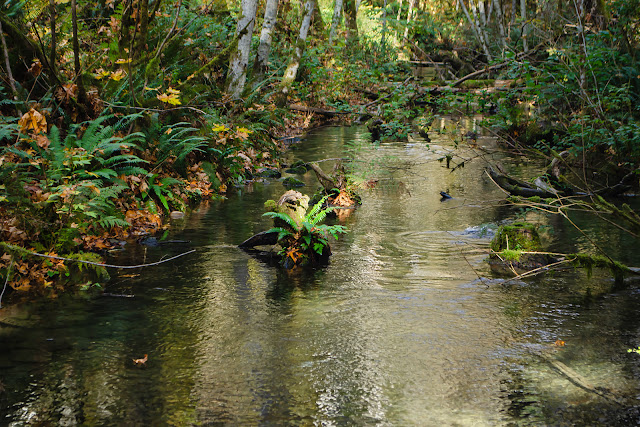I was hoping for bears. They had promised me bears. Well, sort of; my friends were going to show me where they had seen several black bears in the Quinsam River a couple of days before.
The Quinsam River is a short stream that flows into the Campbell River, 20 km. long, as the crow flies, over 40 as it winds down from two small lakes. Good fishing; there are salmon and trout; where we looked down into the water, the salmon jostled each other in the shallow water, big fish, mostly heading upriver to spawn. And where there are spawning salmon, there are bears, fattening up for the winter sleep.
We saw no bears.
But there were pretty green and yellow banana slugs.
 |
| Banana slug, Ariolimax columbianus, and moss on a halfway fallen tree. |
 |
| Cabbage white butterfly, Pieris rapae, female. (The females have 2 black spots on the forewings.) |
It was a beautiful fall day, raining off and on, but the sun shone even through the rain, and the wet forest glistened.
 |
| Bottom to top: salal, huckleberry, big-leaf maple, evergreens. |
And there were mushrooms everywhere.
 |
| Pholiota sp. on a well-aged alder log. |
 |
| Coral mushroom. |
 |
| An unidentified small mushroom, draped in spider web, growing on a snag. |
But no bears. I'll just have to go back another day.
- Babosa Ariolimax columbianus en un tronco medio caído.
- Y una mariposa Pieris rapae. Las hembras tienen las dos manchas negras en cada ala anterior.
- Era un dia lindo de otoño; llovía en momentos, pero el sol seguía penetrando las nubes aun mientras llovía, y el agua en las hojas del bosque centelleaban.
- Y por dondequiera había hongos. Estos son del género Pholiota.
- Hongo coral.
- Hongo sin identificación creciendo en un tronco muerto.












